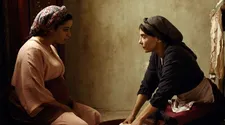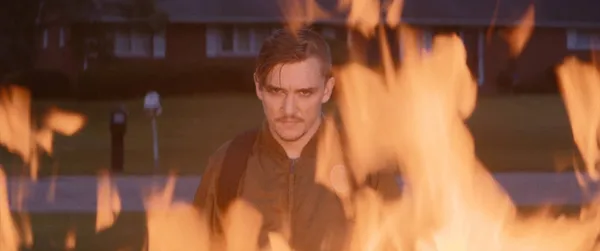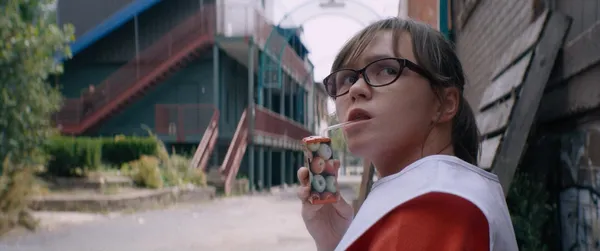 |
| Adam Rehmeier on Emily Skaggs and Kyle Gallner as Patty and Simon: 'They brought the humaneness to it that wasn't on the page per se' Photo: Courtesy of Arrow |
Adam Rehmeier's Dinner In America is a punk-spirited romance with an anarchic energy that sees anti-hero Simon (Kyle Gallner) strike up an offbeat friendship with Patty (Emily Skeggs), a girl he meets by chance but who has a deeper connection to him than either of them first realise. Spiky comedy is blended with sweetness as the pair forge a connection, make some beautiful music together and raise a fair bit of hell in the process. We caught up with Rehmeier to chat about the film ahead of its June 1 VoD release.
Your film premiered at Sundance just before the world went on a pandemic rollercoaster because of Covid, how has that affected the journey of the film?
 |
| Adam Rehmeier: 'I believe that a film should have a single filmmaker's vision behind it, that it should never be a committee, that one person should should decide the path' |
We did the Sundance screening. And then there was one more that's like a "straight from Sundance" series at Cinetopia in Ann Arbour in Michigan, where I live. So Kyle and I did one more screening together and the pandemic happened, like it started the next week. So we had this last experience with a huge crowd of 1000 people and stuff. It was fun, this film plays so well with a big crowd of people getting wrapped up. So, it's been very, I mean, disappointing would be an understatement. It took six years from when I wrote the script to when we premiered it. So it's a huge span of time. And I wrote and directed the film, but also edited the film. So that means that in post-production all of that time, I'm working and working and refining. And so you, as a filmmaker, get to the point where these festivals and stuff are a much needed purge of all your energy and hard work.
Yes, it's like the pay-off. I feel like filmmakers are getting denied the fun. Although, I know making a movie to a degree is fun, but it's still your job.
Pain, all of it's really straight pain. But this cast and crew were really great, we developed a great rhythm working together. It's one of those rare projects because every 10 or 15 projects you hit one that really feels like a family unit making things and that's always really cool. And the relationships I made, especially with Kyle and Emily ... I've made lifelong friends now and we're going to work together more.
Have you been left scarred by the middle America dinners of your life?
I think I definitely had pulled from many experiences and running the gamut of, of things that I've witnessed and seen and that I certainly feel. But a film is a canvas that is layered all the way down. In this film, in particular, I was heavily involved with sound design too. Conceptually, I really think that way. You've got to think about every single thing that's happening in the film. And there's a lot of people that are just sort of on autopilot when it comes to that because they're out of their comfort zone. But I started in music and that's my whole background so I'm always very aware that not only is film a visual medium, but you know, like, your auditory senses have to be going crazy, too. So, like, there's washing machines - you were not able to see it in the glorious 5.1 Dolby Surround, but there's stuff spatially placed in this movie that's very dear to me. So I think there's like an attention to detail to not only what things visually look like in a film, but also how they should sound.
So you had a lot of control in this project - you were very hands on.
To me, there's no other way to do it, it doesn't make sense. I believe that a film should have a single filmmaker's vision behind it, that it should never be a committee, that one person should should decide the path. And that everyone needs to rally behind the filmmaker for that vision, they need to believe in it. So, it's your job as the filmmaker to articulate those things so people understand. You can't just be quiet and not express those things, you have to be very specific, especially in filmmaking, because you don't have money. So you have to articulate what you want, in order to execute it quickly.
It comes through in your film, which feels quite singular. There's a very strong sense of personality that comes across. It's quite funny in that even though it's a very punk-spirited film, it's also a very romantic movie. I'm wondering if you are a romantic at heart, because it is a very romantic film.
I found that out through the process - that I'm actually a romantic guy at heart. This film broke me at several points, I edited it linearly and when I got to the arcade sequence, when Patty jumped on him, and with him, pulled him down, I just broke down. I just sobbed, it was the most beautiful thing. And so I had my own kind of awakening in the process of making the film, when I started to see the gifts. When you're shooting, you don't have time to react to things. It's like, she'll be in the basement singing a wonderful song. And you're like, 'Okay, great, we're moving on', you know, and it's nothing personal. It's just we have seven pages to do today.
 |
| Kyle Gallner as Simon in Dinner In America. Adam Rehmeier: 'You start to see the gifts when you're in post production, you start to see the nuances' Photo: Courtesy of Arrow |
So you start to see the gifts when you're in post production, you start to see the nuances. And, you know, Kyle's decision making here, Emily's decision making here, Kyle gives me an audible here, Emily's doing something different here, all of those decisions, it's a cause and effect. It's like a house of cards, you build a strong foundation, and you keep going up. But if you start pulling too many of those things, it all falls down. There's a lot of different ways a scene can play or feel. When you start to tinker, you have to look beyond just that scene, you have to look how that affects the rest of the timeline for the whole movie. I think, the biggest gift you can really have is if you have a singular vision for the film, because there is the film that you write on paper. And then you get these collaborators in, and they're bringing their energy in and it's a hybrid now of it all.
You're in post production, and you're sifting through all of this stuff. I think it's always a good thing to to budget just a little bit more for posts, so you can make those decisions and live with the film a little bit longer. That's one thing that was great about this is that we didn't have any super pressing deadlines. We shot the film in late August, early September, basically securing that we missed every festival deadline, you know, for the head of the year.. So I had a really robust edit period, and I had time for it to breathe. I had time for it to resonate with me and to kind of sit back and think, do I like that? Do I not like that? What do I want to do here?
You've talked about the collaboration. Emily and Kyle are excellent and they bring a lot of nuance to what could be kind of cartoony I think in the wrong hands.
I think on paper I've said quite often it plays a bit like a Warner Brothers' cartoon, you know, we're very cold, hot, cold, hot, cold, hot. So it explodes and then has a little quiet part, it builds back up and explodes. They brought the humaneness to it that wasn't on the page per se. I mean, it was there, but they deepened it to another level. So you know, that's what can be achieved when you believe in your talent. You become flexible - it's their image that is now embodied, your words are channelling through their body, and they're the vessel for it. So you have to have some respect.
I would say 90% of what you need to decide has to happen as you cast them. The other 10% is sort of a fine tuning and they're getting to know you. And you know, in the case of this particular film, I had a very clear idea of what I wanted to do to bond with them, which is to just do the music first. So we had a two-week rehearsal period. I didn't spend that line reading from the script. What we did was we recorded Kyle's Psyops tracks on day one.
So they flew in, we had dinner, and I said, "I'll pick you up at night at nine". I got Kyle and Emily, we went to the studio, we recorded all of Kyle's stuff, we had the punk band coming in, and we basically did all the album stuff and the live tracks that day. The next day, Emily and I went to the recording studio and we figured out the song that we were going to play in the movie, which became Watermelon. So she brought lyrics that she had written as Patty, in character, to Simon as part of her prep work for the film. I grabbed a guitar and we just started kind of riffing. And that song is what happened in the half an hour. Next day, I went back in the studio, and I laid down the drums and the guitars and Emily sang - she did two takes and that was the second day.
The simplicity of the song works really well within the context of the film.
It would be horrible if we did this thing and it was operatic and it went into this whole other thing and they lay down way too much. I wanted something that it felt like these two people could record together in 20 minutes. The engineer who was helping was like, "Wouldn't it be cool if this happened?" And then I was like, "No, it needs to be stripped down and very simple". The music thing is my thing. I'm a home recorder and I've been doing that for 30 years. So this was a way for me to, I guess, showcase what that kind of feels like when you do it.
So you have an additional layer of attachment to this, beyond being the director, because of the music. That's probably what I romanticise the most you know from my own life. I have a family now, I'm married, I have three boys, but I do romanticise about a time period when I could just go and record and play all night and it wouldn't bother anybody. That part's cool, you know? Yeah, this was a way for me to show what that meant to me. It meant a lot to me to have Emily as the vessel, to witness that. I felt like Kyle watching her, we were all crying when we did the scene.
Patty's an interesting character, in many ways the more complex of the two of them.
Absolutely. I think she's the growth character. And Simon is very steadfast in his thing. I want to do strong female work, you know. I and I've received a lot of compliments about Patty - a lot of people of all ages really connect with her. I wanted that. It just made a lot of sense for that torch to be in her hand at the end of the movie.
You say you're hoping to work with Emily and Kyle again are there any projects on the go at the moment?
I don't have anything currently for Kyle and Emily. But my point with that is just having them on the roster of available go-tos. Now, it's a thing where I'll hand-tailor something for them knowing their strengths, or it would be great to collaborate with them in that way. I'm so open to it but some projects I have, it doesn't quite fit. I want to build a kind of an eclectic catalogue of films. So it's just gonna depend, but they always have, they always have a place from now on.
Are you working on stuff right now or is Covid cramping that?
Yeah, I'm writing a project, but I have several things to direct and other things that I've written to do. So it's more just like waiting, you know, for them to actually go. So it's been really slow. I have a lot of energy for it, I have a lot of passion for just the work itself, the craft. So, for me, it's really hard having all of that locked down, and not being able to do it. I draw a lot of inspiration as I move around in the world, from the people that I meet and their energy, having the exchanges now, I can't see anyone's faces. A huge part of my process is just moving through space time, I'm an observationalist. I'm listening and looking and studying things and people. So it's hard to not be able to do that right now.
Dinner In America is streaming on Arrow and available to buy or rent on all digital platforms in the UK from June 1 www.ARROW-Player.com (a 30-day free trial is available). It is also available from Apple TV, Amazon, Google Play, Sky Store, Microsoft, Kanopy, priced £9.99 to buy and £5.49 to rent






















